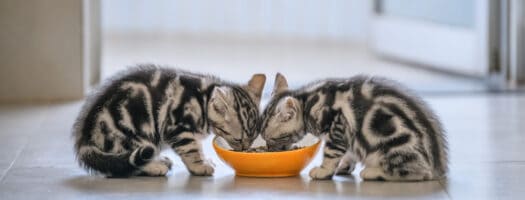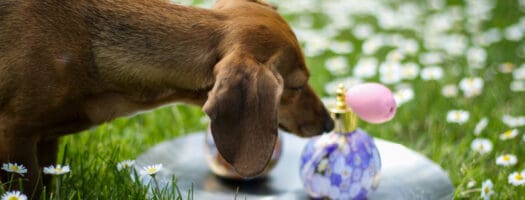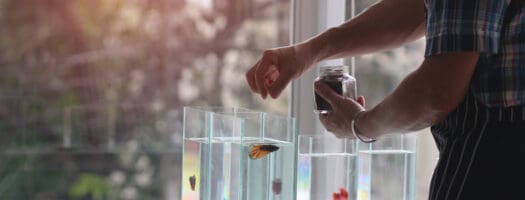The 10 Best Organic Cat Foods in 2024
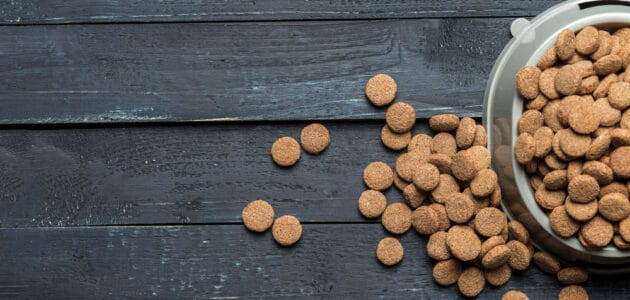
Just like the food we eat, pet food today is far from what it once was. From hormones and antibiotics to pesticides and inhumane conditions, the food on the table isn’t what it would be if we farmed our own, which many pet owners believe is less healthy and less ethical.
This is why more and more of us are eating organic and why we want that same ability for our furry loved ones. Fortunately, pet food providers have listened to our concerns, and today there are dozens of natural and organic cat foods on the market.
- What Is Organic Cat Food?
- Choosing the Right Organic Cat Food
- Top 5 Best Wet Organic Cat Foods 2024
- 1. Best Overall Pick: PetGuard All Natural Wet Canned Cat Food
- 2. Best Premium Pick: Castor & Pollux Organix Canned Wet Cat Food
- 3. Best for the Environment: Evanger's Organics Dinner for Cats
- 4. Best for Health Maintenance: Wellness Complete Health Pate
- 5. Best Limited Ingredient Organic Cat Food: Natural Balance L.I.D. Wet Cat Food
- Top 5 Best Dry Organic Cat Foods 2024
- 1. Best Seafood: Open Farm Catch-Of-The-Season Whitefish Recipe
- 2. Best Budget Pick: Tender & True Organic Chicken & Liver Recipe
- 3. Best High-Protein: ORIJEN Dry Cat Food
- 4. Best for Urinary Support: Yarrah Organic Grain-Free Dry Cat Food
- 5. Best Charity-Supporting: Rachael Ray Nutrish Zero Grain Dry Cat Food
- Guide to Buying the Best Organic Cat Food in 2023
- Final Thoughts
What Is Organic Cat Food?
Organic cat food is more than just cat food free from hormones and pesticides. To be truly organic, every part of the process must qualify, from the ground that vegetables are grown in to the amount of room chickens have to move around. Organic cat food contains no genetically modified ingredients and is free from any artificial chemicals. For meat to be truly organic, the feed it is given must be organic.
Choosing the Right Organic Cat Food
We refuse to recommend food that contains artificial additives, hormones, or ash, all of which are bad for cats. Still, there are differences between “natural” foods that contain organic ingredients and certified organic cat food. What’s more, ingredients, texture, and price can all play a role in what cat food you choose.
Organic Cat Food Certification
Pet food companies take pride in being able to display a United States Department of Agriculture (USDA) “certified” label. By passing their stringent conditions, the companies show a dedication to the organic process. Our Best Organic Cat Foods in both wet and dry categories are USDA certified. Other respected organic food certifications include Oregon Tilth and the Global Animal Partnership.
Health Benefits
Organic cat food is not automatically healthy cat food. The ratio of meats to vegetables, the appearance of grains and gluten, as well as levels of omega vitamins all provide a role in determining the healthiest food for our feline friends.
Healthy cat food should contain:
- High levels of animal-based protein
- Low or no grains
- Only a reasonable amount of liver
- A range of vitamins and nutrients including salts, omega-3 and 6, and taurine
For a fuller explanation of what makes cat food healthy and what we can do to ensure the best for our animals, please check out our full buyer’s guide.
Choosing Between Wet and Dry Cat Food
Pet owners have a range of opinions about wet and dry food, and as our buyer’s guide shows, there are benefits to both. While we recommend using a mix of both wet and dry for the best health of our cats, not everyone thinks the same.
To make choosing easier, we have offered the top five wet and top five dry organic cat foods. Our personal choice would be a combination of the PetGuard All Natural Wet Canned Cat Food and the ORIJEN Dry Cat Food.
Cats that love seafood may prefer a mixture of Natural Balance Limited Ingredient Diets in Salmon, with the Open Farm Catch of the Season Whitefish Recipe.
Cats can be very picky eaters and are prone to allergies, digestive problems, and special needs (such as kidney or diabetic issues). Included in our list are foods specifically designed for these circumstances.
Now that you have an idea of what to look for, lets dive right into our list.
Top 5 Best Wet Organic Cat Foods 2024
1. Best Overall Pick: PetGuard All Natural Wet Canned Cat Food
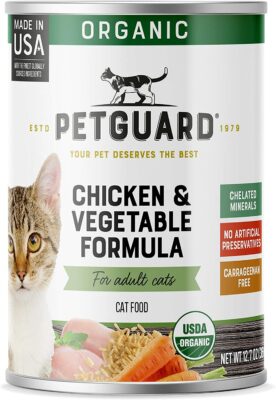
Editor’s Rating:
Why we like it: Created by using organic and cage-free poultry, PetGuard products are highly transparent with their ingredient lists and do not contain liver.
Just the Facts:
- Main Ingredients: Chicken, chicken broth, turkey, brown rice
- Number of Meals: 24
- Grain-Free? No
- Certified Organic? Yes
PetGuard was founded in 1979 as the first all-natural pet food company in America and has maintained a high reputation in the industry. Its USDA-certified food is made by cage-free animals and organic vegetables and is one of the few organic cat foods that contain no liver. High in protein, as well as omega-3 and 6, PetGuard’s cat food is supplemented with natural vitamins from only organic materials.
While not entirely grain-free, this is only due to a small quantity of oats and rice, which provide a non-gluten alternative for providing fiber in the diet. PetGuard is one of the most expensive options available when it comes to organic cat food, but it offers the best ingredients with the greatest transparency.
For peace of mind in the knowledge that your organic cat food truly is from the most ethical sources, without decreasing the healthy benefits of that food, PetGuard is the best of a wide range of wonderful choices.
Pros
- Transparent as to the source of fats and oils
- USDA-certified
- High in Omega 3 and 6
- No liver
Cons
- Contains oats and rice
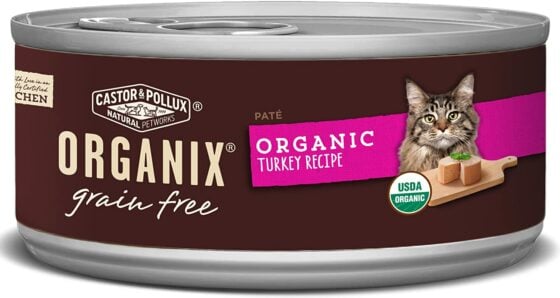
Editor’s Rating:
Why we like it: The Organix Range uses the highest quality ingredients and is cooked in a USDA-certified kitchen, offering a boutique brand experience.
Just the Facts:
- Main Ingredients: Turkey, water, chicken, chicken liver
- Number of Meals: 24
- Grain-Free? Yes
- Certified Organic? Yes
Completely grain-free, and having both farms and kitchens certified by the USDA, Castor & Pollux have chosen only the highest quality ingredients for its organic cat food. This includes coconut and flaxseed, which help provide a balance to the blood glucose of cats suffering from diabetes.
The pate also includes cranberries for urinary health and calcium for strong teeth and bones, and alternate pates made from chicken are also USDA certified. While there is not enough liver to be concerned about as an owner, the inclusion of the ingredient is the only thing stopping the Organix cat food from being the healthiest choice available.
Castor & Pollux is a boutique brand, and often demand outstrips supply. For this reason, we recommend buying in bulk to avoid what can be quite large fluctuations in price.
Pros
- High in proteins and fats
- Cooked in an organically certified kitchen
- Recommended for cats with diabetes
- Offers chicken meals with the same certifications
Cons
- The price can fluctuate wildly due to demand, so best to stock up when cheap
3. Best for the Environment: Evanger's Organics Dinner for Cats
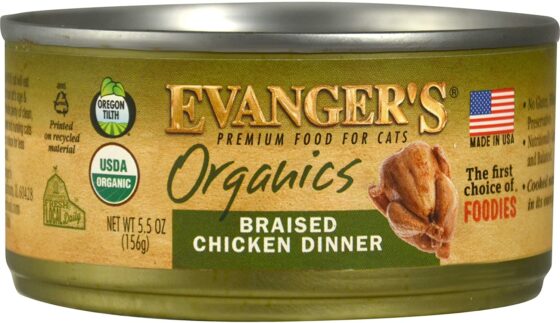
Editor’s Rating:
Why we like it: Made in the USA from certified organic products, this cat food has been perfected over the last 85 years. The family-owned business cares about every aspect of their product, from protein content to packaging.
Just the Facts:
- Main Ingredients: Turkey, water, liver, butternut squash
- Number of Meals: 24
- Grain-Free? Yes
- Certified Organic? Yes
Evanger’s has gone the extra step with their organic cat food by considering the impact that their packaging has on animals and the environment as well. Recognized as the most eco-conscious pet food by the Sierra Club (the USA’s largest grassroots environmental group), Evanger’s uses recycled and recyclable materials in all its packaging and labeling. Without decreasing the quality of its organic ingredients, it also ensures that it sources them from farms within fifty miles of its kitchen. If that wasn’t enough to make it the cat food with the most certifications, it is also recognized as kosher for animals by the Chicago Rabbinical Council.
It is unfortunate then, to find the liver as the second-most prevalent source of protein in Evanger’s Organics, even if it is well below a worrisome level. Unsurprisingly, this particular brand of cat food is also one of the more expensive options, passing on the costs of making it the most ethical choice for the consumer.
When choosing organic food because of ethics more than diet, Evanger’s is the ultimate choice.
Pros
- Certified kosher by Chicago Rabbinical Council
- Recycled and recyclable packaging
- A long-running family company
- Made from start to finish in the USA
Cons
- Contains liver
- Expensive
4. Best for Health Maintenance: Wellness Complete Health Pate
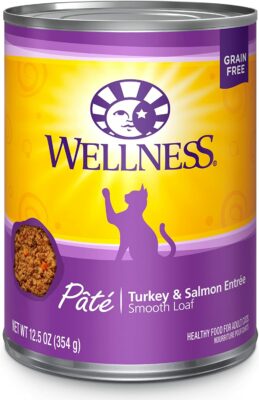
Editor’s Rating:
Why we like it: Created by veterinarian nutritionists, this cat food is high in protein and contains fruits and vegetables that promote urinary health.
Just the Facts:
- Main Ingredients: Turkey, chicken liver, whitefish, chicken broth
- Number of Meals: 24
- Grain-Free? Yes
- Certified Organic? No
Wellness Complete Health Pate emphasizes a healthy diet above everything else. That is why it is the wet cat food with the highest crude protein content available, is high in Omega-3 and antioxidants, and focuses on natural sources for its vitamins.
Wellness Complete Health has a range of other cat food, including dry varieties that are made with mixing in mind. For a diet that combines wet and dry food, this ability to choose the same brand can be important. The recipes available can also come in a range of textures, from the pate to morsels and even gravy.
Perhaps it is the focus on health that has left this cat food without official organic certification, but all ingredients come from sources free of pesticides, hormones, or additional artificial additives.
Pros
- 10% more raw protein than other wet food
- Higher levels of omega-3 from fish and fruits
- Recommended for urinary and immunological health
- Can be mixed well with the brand’s dry cat food
Cons
- Not certified organic
5. Best Limited Ingredient Organic Cat Food: Natural Balance L.I.D. Wet Cat Food
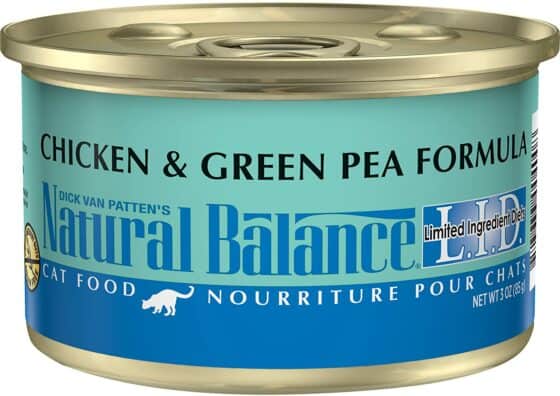
Editor’s Rating:
Why we like it: With less range of ingredients, selected with the healthy cat in mind, this food is especially good for maintaining the silky shine of a cat’s coat.
Just the Facts:
- Main Ingredients: Chicken, chicken broth, chicken liver, ground peas
- Number of Meals: 24
- Grain-Free? Yes
- Certified Organic? No
Natural Balance works off a simple philosophy. The fewer ingredients, the more natural the diet. Still, to ensure that your cat gets everything it needs, the company employs a range of veterinarians that are experts in feline nutrition, as well as microbiologists and chemists to test their final products. The Natural Balance Limited Ingredients Diet is the only one to rely on ground peas, which many owners say their cats prefer over other choices.
Unfortunately, this cat food does contain the upper limits of liver one would like to see in a diet, and despite claiming to use all-natural ingredients, is not certified organic.
A simple premise can go a long way to providing confidence, and Natural Balance doesn’t fail to produce on its promises for limited ingredients and healthy options.
Pros
- Designed by veterinarian experts in nutrition
- Tested by microbiologists
- Also comes in duck and salmon
Cons
- Not certified organic
- The highest proportion of liver
Top 5 Best Dry Organic Cat Foods 2024
1. Best Seafood: Open Farm Catch-Of-The-Season Whitefish Recipe
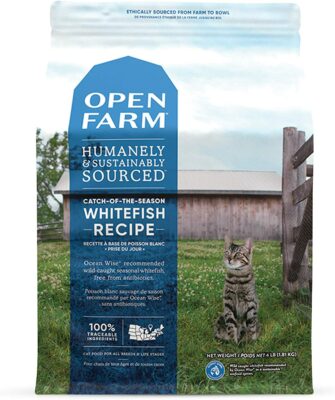
Editor’s Rating:
Why we like it: Sustainable, fresh seafood is dehydrated to make one of the tastiest dry cat foods available.
Just the Facts:
- Main Ingredients: Whitefish, whitefish meal, herring meal, chickpeas
- Weight: 4lbs.
- Grain-Free? Yes
- Certified Organic? No
It may come as a surprise to you that our favorite seafood choice was a dry cat food, but when it comes to sustainable, wild-caught food, Open Farm is the brand you want. Its fish is certifiably sustainable by Ocean Wise, and being a very large portion of the recipe means a high omega-3 and 6 content.
The Catch-Of-The-Season’s highest non-meat ingredients are Non-GMO chickpeas and coconut oil, some of the highest-quality choices available. The high proportion of whitefish and whitefish meal makes this dry organic cat food one that is most enjoyed by cats, while chicory root, coconut oil, and rosemary add to its healthiness.
Open Farm offers a range of other options, all certified by Ocean Wise or The Humane Farm Animal Care Program. This guarantees that their meats, at the very least, are organic and humanely sourced.
There is little bad to say about Open Farm. We wish it had been certified by the USDA because it ticks all the boxes. While one of the more expensive dry options, it is cheaper than many of the wet organic cat foods, while containing higher quality ingredients.
Pros
- Sustainable, Non-GMO, humanely sourced ingredients
- Certified by Ocean Wise and The Humane Farm Animal Care Program
- High-quality ingredients
- One of the tastiest options
Cons
- Not certified by USDA organic
2. Best Budget Pick: Tender & True Organic Chicken & Liver Recipe
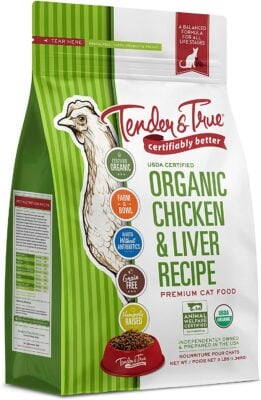
Editor’s Rating:
Why we like it: The least expensive option, without being “cheap”, the priority is on humane, organic food raised humanely.
Just the Facts:
- Main Ingredients: Chicken, chicken meal, tapioca starch, pea flour
- Weight: 3lbs.
- Grain-Free? Yes
- Certified Organic? Yes
Tender & True created the first USDA certified cat food, and ever since they have tried to improve on that. Currently, they are also certified by Oregon Tilth and the Global Animal Partnership. It is the only company that has been confirmed to not only use organic ingredients but also feed its animals organic food in the process. Tender & True is an independent American company that grows its own food.
While the recipe advertises itself as Chicken & Liver, the liver amounts were not as high as we expected. We were more concerned to find the presence of potato starch, but it is still better than grains.
Sometimes we associate the word “budget” with low-quality. Tender & True’s organic cat food proves that this isn’t always the case.
Pros
- Best certification for organic and humane food
- Grows its own food, also fed organically
- Very inexpensive, without decreasing quality
Cons
- Liver and potato starch
3. Best High-Protein: ORIJEN Dry Cat Food
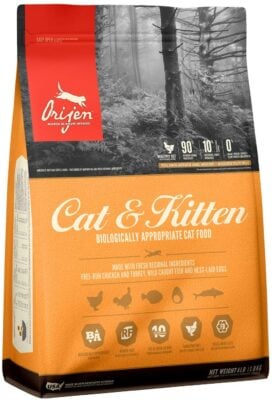
Editor’s Rating:
Why we like it: With less range of ingredients, selected with the healthy cat in mind, this food is especially good for maintaining the silky shine of a cat’s coat.
Just the Facts:
- Main Ingredients: Chicken, turkey, egg, flounder
- Weight: 4lbs.
- Grain-Free? Yes
- Certified Organic? No
Orijen Cat Food contains ninety percent animal products, which helps it provide the highest protein content of any of our featured products and, even when searching the lower quality brands, we could not find any higher. Orijen also boasts the unique “WholePrey Ratio”, which means that while it contains chicken liver, it is the same amount of liver/meat ratio you would find in a whole chicken. This, obviously, is what we want.
While Orijen is not certified, and we cannot vouch for its sourced chicken and turkey, we know that all its fish is wild-caught and eggs cage-free. We also know that no hormones, artificial additives, or artificial preservatives were used.
Pros
- Highest protein diet in any cat food
- Unique “WholePrey” Ratio
Cons
- Not certified organic
- Not entirely transparent about its source of poultry
4. Best for Urinary Support: Yarrah Organic Grain-Free Dry Cat Food
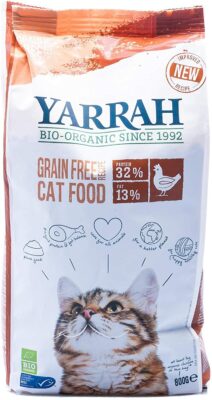
Editor’s Rating:
Why we like it: An emphasis on health and a high level of transparency makes this overseas brand worth looking into.
Just the Facts:
- Main Ingredients: Chicken, green peas, yellow peas, tapioca
- Weight: 2lbs.
- Grain-Free? Yes
- Certified Organic? No
Yarrah is a Dutch brand and therefore doesn’t have USDA certification. But just because it came from the other side of the world doesn’t mean we should ignore just how good a cat food this is.
Yarrah’s bio-organic formula is one-quarter free-range chicken and every source is vetted to be organic, even for the nettle and seaweed. It doesn’t contain chicken liver, grains, or potato.
Speaking of such ingredients, the inclusion of seaweed, nettle, and sunflowers make this a wonderful food for cats suffering from urinary problems, and Yarrah also has a recipe for pet owners concerned with their cat’s weight.
It’s an expensive bag, and from overseas, but for the health of our cats we definitely recommend this organic cat food.
Pros
- Contains seaweed, nettle, and sunflower for urinary health
- ¼ whole chicken
- No liver
Cons
- Overseas product
- Expensive
5. Best Charity-Supporting: Rachael Ray Nutrish Zero Grain Dry Cat Food
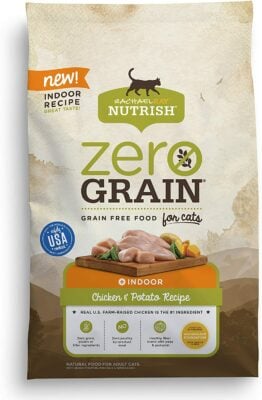
Editor’s Rating:
Why we like it: A portion of proceeds go to the Rachael Ray Foundation, funding veterinarian services around the country but that doesn’t mean the food costs you more.
Just the Facts:
- Main Ingredients: Chicken, chicken meal, ground peas, potato
- Weight: 3lbs.
- Grain-Free? Yes
- Certified Organic? No
The Nutrish Zero dry cat food may not be organic. If absolute confidence is required, this probably isn’t the product for you. That said, there are several other benefits that we could not ignore. Zero grains and zero liver, with only whole meat and vegetables used, this dry cat food is even cheaper than the Tender & True recipe, despite giving part of its proceeds to charity. It keeps the costs down by using potato instead of peas, but there are worse options out there.
Pros
- Proceeds go to charity
- No liver
- Inexpensive
Cons
- High amount of potato
- Not transparent about food sources
Guide to Buying the Best Organic Cat Food in 2023
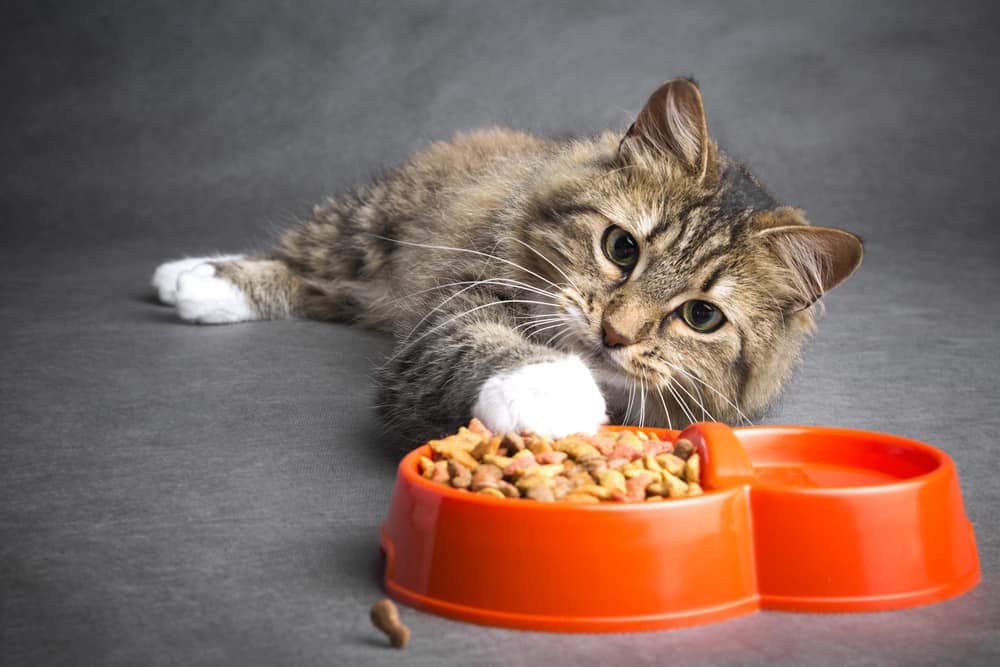
When we care for our cats, we want them to eat as well as we do. This means high-quality ingredients, coming from ethical sources, free from artificial additives and preservatives. Still, it can be different to wade through all the different options out there, to understand what makes something truly organic, and know the difference between cat and human diets.
What Makes a Food Organic?
Any cat food can advertise itself as “having natural ingredients”, as it isn’t a legal term. They do so when they can say that their food is free from artificial additives, and it helps them stand out. Sometimes it helps them increase their prices.
For food to truly be organic, however, they must be free from Genetically-Modified Organisms (GMOs), radiation, pesticides, and hormones.
USDA Organic Certification Process
The United States Department of Agriculture (USDA) offers a legally-binding certificate to products that meet strict guidelines for being organic. These guidelines include:
- Farmyards must have spent the last three years with no prohibited substances used. Such substances include radioactive material, pesticides, and chemicals.
- Animals must not be given hormones or antibiotics and must be kept in humane conditions, making them “free-range”.
- Additional preservatives, flavors, colorings, vitamins, and enzymes must also come from organic sources.
Those products that meet the stringent requirements of the USDA may then show an approved seal on their packaging. While a product without this seal may still be organic, it is a simple way to guarantee the product you are buying. If a product does not have the seal but advertises as “having organic ingredients”, it must legally still have 70% or more organically sourced ingredients.
Four of our chosen products have the USDA seal, while another two use the term “organic ingredients”. Of the remaining four, our research shows at least three use organic practices.
Ethical Pet Food
Organic cat food is more ethical than other forms, as it requires free-range farming and practices that do not involve hormones or unhealthy antibiotics. However, some organic cat foods want to offer the most ethical options available. For example, the Evanger’s Organics Dinner for Cats uses recycled and recyclable packing, while many seafood options include wild-caught fish. For those of us who choose organic food as much for ethics as health, it is important to consider all these extra features.
Organic Cat Food and a Healthy Diet
According to the Mayo Clinic, “There is a growing body of evidence that shows some potential health benefits of organic foods when compared with conventionally grown foods”. Organic foods are guaranteed to be free of toxic materials, radiation, and pesticides, while generally having higher levels of omega-3 and vitamins.
Organic food can come with risks, including an increased likelihood of bacteria. However, the way pet food kitchens operate decreases this risk greatly.
While organic cat food is better for our feline friends, there are a number of other factors that we need to consider to offer the healthiest option for them.
Choosing the Ideal Diet for Your Cat
Cats require a balanced diet with enough protein, vitamins, fat, and sugars to have a long and healthy life. All cat food is regulated to ensure that some balance exists, but some cat food companies spend more resources on ensuring the absolute best recipes.
Animal Protein
Cats are obligate carnivores. This means that they need the protein specifically from animal meats and while a vegetarian diet is possible, it is not recommended. Vets recommend cat food that has at least 25% protein, animal sourced. The more, the better. The ORIJEN Dry Cat Food has forty percent protein and is a good choice to be mixed with some of the less protein-rich wet foods.
Grain-Free Diets
Cats don’t naturally eat vegetables, and this is especially true for grains. While some researchers dispute the need to avoid grains, cat owners around the world swear that their cats are less itchy, less fat, and less irritable when fed grain-free formulas. Some cats are actively allergic to gluten.
Low Liver Diets
While liver is okay to find in cat food, too much can lead to vitamin A toxicity, which affects their bones, joints, and muscles. Liver and other organs should only be present in food as much as they would be in raw meat.
Which Is Better: Wet or Dry Cat Food?
It’s the topic so important that we split our list of best organic cat foods based on it. There is a lot of information we’ve heard over the years from family, friends, and even vets (who sometimes contradict each other). So what is the truth about wet and dry food, and what should we really be doing?
Is Dry Food Better for a Cat’s Teeth?
The simple answer is “yes, but raw food is even better”. Dry food provides rough surfaces for those cats who chew their food. The problem is that many cats do not chew dry food (as you would know from any unfortunate time your cat has vomited). Raw foods that contain bones must be chewed, and therefore are more likely to promote dental health. Unfortunately, they come with other risks, and rarely provide everything a cat needs.
How Important Is Moisture in Food?
Very. And this is one of the most important reasons to choose wet organic cat food over dry. Cats who live off dry food alone are more likely to end up with kidney issues, and dry food is often harder to digest. Wet food is also enjoyed by more cats, capturing a stronger taste than dehydrated food. Sure, it’s smellier for us, but to our furry friends, that is like experiencing the tempting odors of the family kitchen.
What About Storage?
Dry food stores longer, and leftover wet food will need to get discarded. For a grazing cat on a summer’s day, this is an important consideration.
Are There Any Other Factors?
There is a small increase in thyroid disease for cats that only eat wet food, and dry food alone has a chance to cause severe gastrointestinal issues.
So What Is the Best Choice for a Healthy Cat?
The best option for our cats is a mix of dry and wet food. Pet food companies know this, too. That is why Wellness Health designs its wet food to be combined with dry. That is why the nutrient balance is so different between wet and dry. By combining them, there isn’t an overabundance of carbohydrates or underabundance of protein. By combining them, there is the right amount of all nutrients, the right moisture, and the right taste to make our cats happy and healthy. Taking the more expensive wet food and mixing it with dry makes it more cost-effective, and it improves cat digestion and oral health.
That’s the answer, as simple as it is. Take our list, take one from each category that suits you, and purchase them both. This is the best way.
FAQ
There’s always the little questions in the back of mind, from vocabulary to feeding habits, and those common myths about cat food that we might be embarrassed to ask. Hopefully, these little answers can help us all be more confident about how we take care of our kitties.
How Often Should I Feed My Cat?
Cats are natural grazers, and the perfect situation is a bowl always available. Of course, in some climates and environments, wet cat food is not suitable all the time, and some cats are brought up to expect set meal times. This isn’t unhealthy but we do recommend spreading food across at least five meals, measuring carefully to ensure we do not overfeed.
What Is Taurine?
Taurine isn’t as scary a word as it sounds. It is a natural component of animal meat and important to feline eyesight. It is a good thing when we see it in the ingredients list of our cat’s food.
What Is Omega-3 and 6?
Both found very commonly in fish, omega-3 and 6 promote good skin and hair, as well as better brain function. This is equally as true in humans, which is why we are recommended to include fish in our diet as often as our cats are.
Why Do They List Some Specific Ingredients Separately (E.g., Vitamins)?
To ensure a healthy amount of nutrients, companies often add extra vitamins that have been extracted from other sources. In organic cat food, these sources must legally be organic, so while not listed, you can be comfortable in the knowledge that the right thing is being done.
Can I Just Feed My Cat “Human Food” or “Dog Food”?
While you can mix your own cat food if you have the knowledge, just feeding the cat what is on your plate, or choosing a less expensive food for dogs can have serious health implications. This should not be done. That said, if your cat has gotten into the dog food, or stolen a piece of chicken from your plate, it will not make them sick.
Is It Okay to Give My Cat Milk?
Milk is not okay for regular cat consumption. Most cats are lactose intolerant, and those who are not would be receiving too high an amount of fats in their diet by regularly drinking milk.
Why Do I Have to Be Careful About Changing Cat Foods?
Cats are creatures of habit, both in taste and digestion. Sudden changes in diet may cause your cat to eat less and can cause serious stomach issues. It is always better to transition slowly by mixing in quantities of the new food, slowly changing the ratio over several weeks.
Final Thoughts
If we believe that it’s more ethical for us to eat organic food, don’t our cats have the same rights? There is a range of organic cat food products out there, and the best take into account the special dietary needs of our cats, as well as how they work as ethical companies.

